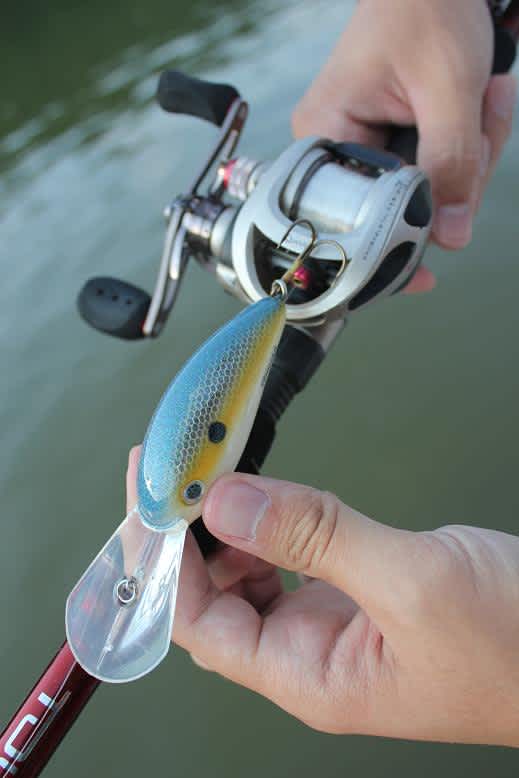The Secret Technique of Long Lining
OutdoorHub 06.01.12

Professional bass anglers are a secretive group when it comes to how they catch their fish. Sure, they’ll go into great detail about what rod, reel and lure they caught them on, but they dance around the subject of “how,” especially if it’s a new technique.
Although the long lining technique has been around for awhile, few professional bass anglers saw its true potential. That was before a number of Bassmaster Elite Series anglers used it to catch heavy limits of big bass on it in a recent tournament.
The technique of long lining allows a deep diving crankbait to achieve depths unattainable with a long cast and retrieve. It even gets a deep diving crankbait deeper than with a long cast and utilizing the technique of kneeling and reeling, when an angler makes his cast and positions himself on the edge of the boat while shoving the rod tip deep below the surface. In the past, kneeling and reeling with deep diving crankbaits was the only technique that allowed anglers to achieve super-deep depths.
Another significant factor when long lining to attain these depths was the introduction of fluorocarbon fishing line for crankbait fishing. Although it’s popular among anglers when pitching or flipping, its inherent properties of limited stretch and sinking characteristic prompts deeper cranking depths with increased sensitivity when fishing a deep diving crankbait.
Long lining is similar to casting and reeling for deep, offshore bass with the exception of presentation. When casting and reeling, an angler finds the school of bass and moves off to the side and makes a long cast overtop, bringing the crankbait through the school. That may include the technique of kneeling and reeling to keep the crankbaits in the strike zone longer. When long lining, however, an angler locates the school of bass or even individual bass on his sonar unit, turns and makes a cast, then loops around the bass with the line overtop of them while using the trolling motor (or even the big motor) to move away while the reel is still disengaged, taking out almost all of their fishing line.
When first engaged and reeling, the angler cranks 30- to 40-yards of line as fast as possible then slows to a normal, steady retrieve. To achieve maximum depths, anglers will often use the knee and reel technique at the same time.
The secret is out, but there are still a lot of questions about how to catch fish long lining. It wasn’t hard to find a professional bass fisherman willing to share the details. Bassmaster Elite Series pro Timmy Horton has utilized this technique for several years on Pickwick Lake and Lake Fork to catch deep, offshore bass.
“Long lining crankbaits doesn’t work on every lake; in fact, it’s rarely productive on lakes with a lot of standing timber like Beaver Lake in Arkansas or Table Rock Lake in Missouri because you are always hanging up in the trees. Reservoirs like Pickwick Lake in Alabama or Bull Shoals Lake in Arkansas are great example of lakes to long line on. You are really looking for barren lakes with little offshore structure or cover,” Horton said.
Another crucial factor when long lining is water clarity. Horton likes to be able to see at least 3- to 4-feet deep or more when long lining.
“Water clarity is important because I am getting my crankbait down to depths of 25- to 40-feet deep and keeping it in the strike zone for long periods of my cast,” he said. Horton also considers the thermocline if one is present. “I will try to keep my deep diving crankbait in or just above the thermocline when there is one. Bass will be located right there.”
Locating the bass is the key to success when long lining. Horton uses his outboard engine to drive the boat around watching his sonar unit for schools of bass.
“The key is finding schools of bass, not schools of bait fish,” he said. “Even though there may not be any bait fish present, bass will eat a crankbait when you reel it by them in deep water. After finding a school, I use the trolling motor to set up my long cast and retrieve.
One advantage that professional angler Horton has that makes a difference when long lining is experience on the water and being able to read his sonar unit.
“Bass that are located offshore on barren structure have a unique look on a sonar screen. They set up in a way I can tell that they are bass down there,” said Horton.
Like most professional anglers fishing the Bassmaster Elite Series, Horton uses high-quality sonar units that feature both down imaging and side imaging along with broadband sonar when graphing for fish.
Your tackle selection can make a difference in long-lining success.
“For me it all starts with using the right lure,” Horton said. “Bass will really key in on shape and size. The Bomber BD8 or BD7 not only have the right shape and size, but will dive to extremely deep depths when long lining.”
Rods make a big difference in getting that depth, as well as reducing fatigue from cranking all day long. Horton uses a 7-foot, 4-inch Timmy Horton Signature Series rod. The extra length and softer tip allows him to make a longer cast and reel in deep diving crankbaits without the fatigue that goes along with deep cranking. As for fishing line, Horton uses 12-pound Silver Thread fluorocarbon spooled up on a 6:4.1 gear ratio Lew’s reel. Unlike other reels he uses when fishing a crankbait, Horton will not use any backing when long lining.
The secret is out, long lining is in and it’s proving to be a great way to catch bass deep on barren lakes when nothing else will.

